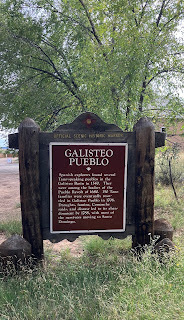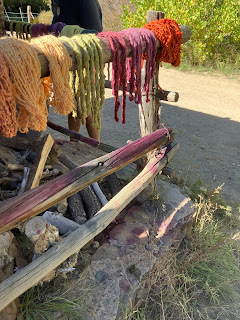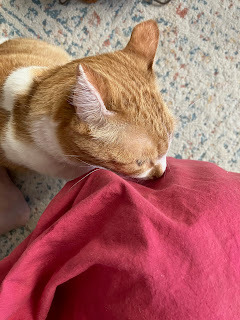Lynne Cantwell's Blog
November 9, 2025
Mail delays in the hinterlands.
I have two topics to choose from for today's post. I'm in the mood for the less serious one. You're welcome. Might do the other one next week -- we'll see.
***
I never thought Santa Fe was the back of beyond until I moved here and tried to get timely mail service to and from the East Coast.
 I wonder if these guys are still around.
I wonder if these guys are still around.ronleishman | Deposit Photos
The most recent debacle happened just this week. Well, actually, it started in mid September, when I was notified that my former employer was switching 401(k) managers (again; they seem to do this every few years). I had meant to stop taking distributions after I went back to work full-time, but I never got around to it because the process of changing anything is a pain in the ass and almost always requires contacting somebody in the Boston office of my old employer. (She's very nice, but I figure at some point she'll retire, and then who would I call?) So this seemed like an opportune time to roll over my 401(k) to an IRA.
Setting up the IRA account was a snap; I did it all online. Next step was to call the firm's 401(k) manager and get the money moved over. The nice man on the phone was happy to help me, but then we hit a snag; the firm was requiring that I fill out some kind of paperwork about my spouse. Spouse? The divorce was final years before I started that job. Anyway, I had them send me the paperwork -- which they did, electronically. It was the same form I had filled out before to initiate and change my distribution.
"Well, okay," I thought, "I'll play your game." I filled it out and sent it back to the 401(k) manager, asking that they electronically transfer the funds to my new IRA account. I was looking at a couple of deadlines: I mistakenly believed I was required to re-home my money within 60 days of the 401(k) manager cutting the check (it's actually 60 days from when you receive the money, and it doesn't apply to direct rollovers anyway), plus there was going to be a blackout period of several weeks where nobody could do anything with their 401(k)s while the paperwork was transferred to the new manager. To make sure I didn't run afoul of the blackout period, I sent the form via FedEx, and received a notice the next day that they'd received it.
The electronic transfer never happened. Several phone calls to the 401(k) manager's customer service folks, plus a call and some emails to my old firm, revealed the reason: this particular management firm does not do direct rollovers electronically. It doesn't matter whether you have $1,000 or $1,000,000 in your account; they always issue paper checks. Mine was cut September 23rd and sent a few days later via regular mail.
You were wondering when the post office would come into it, weren't you?
Waited a couple of weeks; the check never showed. More back-and-forth with customer service and the old firm. We all finally agreed that the initial check was probably lost in the mail and that the management firm would void the original check, issue a new one, and send the new one Priority Mail so we could track it. (At this point, we were in the blackout period, so my contact at my old firm couldn't get into the system to see whether the first check had been cashed. Or issued, even.)
The second check was issued October 24th or so. The day before Halloween, I called them for the tracking number, which they provided. It seemed almost impossible when I got mail from them on Saturday, November 1st -- and it was; the check they'd issued September 22nd had finally shown up, almost six weeks after it was mailed.
I relentlessly tracked that replacement check across the country. It was supposed to be delivered this past Wednesday, November 8th. It got to Albuquerque that day and went out to be delivered here -- whereupon it dropped off the radar. I was mildly panicked, but I held firm; past experience told me it would be delivered here the next day. Which it was. Finally.
***
Why did the first check take six weeks to get here from Boston?
In April of last year, the USPS began easing delivery standards for first class mail. For example, mail that used be guaranteed for delivery in three days wouldn't be counted late if it was delivered in five. At the same time, mail collection times were changed, so that mail that used to be picked up from collection boxes in the morning would now be picked up in the afternoon; in practice, that added a day's delay. More mail is being shipped by truck instead of air to save on transportation costs; of course it takes longer to drive than to fly. And another factor could be a shortage of staff. (It's not because of the government shutdown; the USPS is an independent agency funded by sales of postage and such.)
The whole roster of changes is supposed to be phased in over a ten-year period. Another phase went into effect in April of this year, and yet another just a couple of months ago in July.
I'd noticed the degradation in service earlier. It used to be that I could get birthday cards to my kids if I mailed them a week ahead; now it's taking more like two weeks. Might have to start mailing them a month early, huh?
***
I'd love to blame Trump, but the postmaster general he appointed in his first term, Richard DeJoy, lasted through the Biden administration; his term was up in March of this year. The new guy is David Steiner, a lawyer who used to be head of Waste Management (yes, the dumpster company, and yes, I'm refraining from making the obvious joke) and also sat on the board of FedEx. The ten-year cost-cutting plan was created under DeJoy, though, so we can still blame Trump.
***
Anyway, I deposited the good check the same evening I received it via the IRA provider's app. The deposit was credited to my account the next day. That I could have wrapped all this up a month and a half ago, if only the 401(k) manager would have done an electronic transfer of my money, I refuse to dwell on. This process has been maddening enough.
***
These moments of frustrated blogginess have been brought to you, as a public service, by Lynne Cantwell. Hang in there!
November 2, 2025
Plot twist? At my age?
 Meme stolen from FacebookOne of the things they don't tell you about life after retirement is that stuff keeps changing. And if you didn't develop skills for coping with these new situations in your previous, working life, you have to develop them now.
Meme stolen from FacebookOne of the things they don't tell you about life after retirement is that stuff keeps changing. And if you didn't develop skills for coping with these new situations in your previous, working life, you have to develop them now. I have always believed that the meaning of life -- for me, anyway; your mileage may vary -- is to learn and grow. I just kind of figured that at this stage of my life, the learning-and-growing would be fun stuff, things I picked -- like, say, attempting to learn another language. Not situations that other people have set up, expecting me to react the way someone twenty or thirty years younger would react.
Which is to say that I feel like I'm at a turning point. Again. And in some cases, I don't know what to do -- or else I do know what to do, but I'm reluctant to do it.
My time on the condo board is coming to a close. In the past, these positions have been sinecures, more or less; most owners don't volunteer, so the folks who do keep serving 'til they've had enough and quit outright. But our new management company seems intent on making sure there's actual turnover on the board. So once we have the annual meeting in a couple of weeks (a month earlier I expected, because this management company also wants us to follow the bylaws and hold the meeting in November instead of December), it's very possible that I'll be done. At work, our department manager seems intent on promoting someone (maybe more than one someone) to the next level up the pay scale. That next level involves extra duties and responsibilities. It kind of seems expected that I'd want to move up, and twenty years ago, I would have wanted to. But now? I went full-time figuring I'd coast for five years (or however long it took for the ginormous special assessment to run its course) and then re-retire. Fighting to reach the next level at work doesn't feel like coasting. Re the promotion: One of those extra responsibilities involves training session proofers. I've taught before (Intro to Video Production for one semester at American University), and it didn't feel like a good fit. Oh, I'm happy to explain stuff -- to readers of my books, to listeners when I was a reporter, to visitors at El Rancho de las Golondrinas -- but it's not like any of those folks would be tested on the material. Nobody's future job prospects hinge on remembering the difference between warp and weft. Now, I acknowledge that I could just have a mental block. But I also remember that one of the suggestions on those listicles for Things to Do Post-Retirement is always to teach, and I consciously said, "nope!"I've been attending meetings of a Pagan group hereabouts for most of this year. I haven't gotten a ton out of the meetings (and some of the info the organizers have provided is a couple of decades out of date), but it's been a way to connect with other Pagans/Wiccans in the area. The group was originally slated to keep going for another few months in its current form, but the organizers told us at the last meeting that they're pulling back on their involvement now. This sounds like a great opportunity to reform this group and/or start a new one, right? But I'm hesitant to step up and do it.I never envisioned myself running a Pagan group in my old age -- certainly not while I'm still working full-time. Although I never envisioned myself working full-time after I retired, either, let alone climbing the corporate ladder.And if I reject all of these possible-disasters-cloaked-as-opportunities, what do I do instead? (I hear you out there: "Go back to writing!" It's in the back of my mind, sure, but it probably won't happen while I'm working this particular job. I already spend too much time in front of a computer every day.)
Anyway. I'm not looking for advice or "you can do this!" encouragement. I'm just musing on how even when you think you're settled into a routine, things can change on a dime. Even after you've retired.
***
I'm also aware that November 1st is the start of the new year for many Pagans, including me. So it's apt that these doors are opening and closing now. I just need to spend some time meditating on which doors to step through and which to gently close.
I'll keep y'all posted.
***
These moments of plot-twisty blogginess have been brought to you, as a public service, by Lynne Cantwell. Onward!
October 26, 2025
Historically witchy New Mexico.
Samhain, the Pagan New Year (for some Pagans, at least) -- aka Halloween -- is coming up at the end of this week. And like clockwork, intrepid local journalists around the country will interview some witch or another. It's all pretty harmless these days -- or it should be, unless somebody takes it upon themselves to declare witches brides of the Devil and try to have them executed, or at least shamed out of the community.
It has happened in the past, as you know if you've ever heard of the Inquisition in Europe, or the Salem witch trials here in the US. And New Mexico had a brush with the Inquisition in the 1760s. It happened in Abiquiú, a village better known now as the site of one of painter Georgia O'Keeffe's homes.
 A peaceful fall picture in Santa Fe.
A peaceful fall picture in Santa Fe. Heatherms27 | Deposit PhotosAnd it started with a Franciscan priest named Fray Juan José Toledo, who came to Abiquiú from Mexico City with a manual of ways to spot witchcraft and sorcery -- brujería y hechizería -- and root them out, as missionaries were wont to do, to save the natives from their savagery and bring them to Christ.
I've just begun looking into this; I had a brainstorm yesterday while at Spirit Halloween to offer to portray a bruja during next year's Spirits of New Mexico event at El Rancho de las Golondrinas. The offer's been accepted, so I have a year to study up. But here's what I know so far.
I talked about Abiquiú here on the blog a couple of weeks back -- about how it was created as a land grant to several families of genízaros. You may recall that genízaros were Native Americans of various tribes who were enslaved by Spanish settlers and eventually set free, after they'd been Hispanized and had lost most of their own tribal traditions. Genízaro communities acted as a buffer between communities of settlers and Native Americans looking to attack them. But the genízaros themselves were different -- and feared by some settlers because of those differences.
Enter Fray Toledo. He accused the local men running the town of being sorcerors (in Spanish, hechicero or brujo) and some of the women of being brujas and causing a horrible illness. The illness was real enough -- it caused a fever and a powerful thirst, blackened teeth, and, in some cases, death. There was also a rumor that the stomachs of some of the dead burst open and insects crawled out.
Fray Toledo made enough noise about it that eventually the territorial governor, Tomas Vélez Cachupin, arrested a group of the accused Abiquiú witches and sent to the office of the Inquisition in Mexico City to see what should be done.
By this point in time, the Catholic Church was winding down the Inquisition, and eventually accused Fray Toledo himself of stirring the pot, saying he should stop with the accusations, learn the natives' languages, and work harder on converting them to Catholicism.
So nobody was burned at the stake here in New Mexico. However, some of those suspected of witchcraft were sentenced to servitude in local Hispanic families. Imagine being a member one of these fine, upstanding Catholic families and being forced to take in someone suspected of being a witch! Not a prescription for sleeping soundly at night.
***As I said, I've just begun researching this. I'll let you know how it goes. For this post, I've relied heavily on this article written by Rob Martinez, the state historian of New Mexico.
***This weekend was the 2025 Spirits event at the ranch, our last of the season. It was, as always, a lot of fun. The ranch buildings are especially spooky at night, with the kiva fireplaces lit and candles everywhere. (These days we use LED candles, but the fires are the real thing. I was stationed in the Cuarto de la Familia -- the ranch owner's family's quarters -- and as the night got chillier, a whole lot of guests were happy to just come in and sit by the fire, warm up, and maybe dream a little.
***These moments of historically witchy blogginess have been brought to you, as a public service, by Lynne Cantwell. Happy Halloween! Blessed Samhain!
October 19, 2025
Why I stayed home from the No Kings rallies again.
 Congrats to the millions of Americans who turned out yesterday for No Kings rallies across America. I saw one estimate (but have not confirmed it) that 1 in 50 Americans showed up for one of the approximately 2,700 rallies held in towns big and small around the country.
Congrats to the millions of Americans who turned out yesterday for No Kings rallies across America. I saw one estimate (but have not confirmed it) that 1 in 50 Americans showed up for one of the approximately 2,700 rallies held in towns big and small around the country.Once again, I didn't go. Here's why.
Here in Santa Fe, there are two places for political protests and rallies: the State Capitol, also known as the Roundhouse, and the historic plaza downtown. The No Kings rallies and marches typically start at one and march to the other one, or else they start at the Roundhouse and make a circuit to the plaza and back.
The problem for me is that I work at the Roundhouse. My employer is the Legislative Council Service. We are nonpartisan. We are told when we're hired that our clients are all the legislators, regardless of their political party. We're allowed to have political opinions, of course, but we're supposed to keep them out of the workplace.
Hopefully you see my dilemma. If I participate in a political rally at the Roundhouse, even outside the building on a weekend, it could cause a problem for me at work.
This isn't the first time I've been in this situation. It may be hard to believe today, when media outlets are routinely assumed to be on one side or the other. But when I was starting out in journalism, reporters were supposed to be unbiased -- or as unbiased as it's possible for a human being to be. After all, we were supposed to cover both sides of every issue, and to be fair to both sides. Can't do that if you're taking a public stance on those issues.
Anyway, there are lots of other people who wish they could be rallying but, for one reason or another, can't be there. Luckily for us, there are other ways to be involved -- and one of them is doing what I'm doing right now: showing support on my blog and on social media.
Alert hearth/myth readers know my political proclivities by now. Y'all know I'm there with you in spirit, if not in person.
***
We know we're getting to them when they start to claim that people marching in inflatable unicorn costumes are terrorists and that yesterday's gatherings were "hate America rallies". We had some relief yesterday as they stayed mostly silent while the marches were going on, although Trump himself posted an AI-generated video of him piloting a fighter jet and dumping poop on rallygoers. But as some commenters have said, an image of Trump taking a dump on America is actually on point.
***
These moments of supportive blogginess have been brought to you, as a public service, by Lynne Cantwell. Keep the pressure on! It's working!
October 13, 2025
Indigenous Peoples' Day.
So this weekend, I did a thing I have never done, even though I've lived in Santa Fe for five years and vacationed here for much longer: I checked out a couple of art studio tours. These events are organized by artists who live in a specific location, whether a city, town, or village. Artists who live there agree to open their studios, even if they're in their own homes, and invite the hoi polloi to traipse through, chat with them about their work, and (the gods willing) buy something from them.
Since I rarely do things by halves, I hit two studio tours this weekend: the one in Abiquiu on Saturday and the one in Galisteo yesterday. After I got home, it dawned on me that both Abiquiu and Galisteo were originally pueblos -- that is, they were Native American settlements -- but neither is a pueblo today. So what happened to the Indians? As the saying goes, it's complicated -- and a fitting topic for Indigenous Peoples' Day.
Let's talk about Galisteo first. This sign is right on State Road 41.
 Lynne Cantwell 2025Here's the gist of the text, with some amplification by me: When the Spanish conquistadores showed up in 1540 in what later became New Mexico, they found a bunch of Tano-speaking settlements in the Galisteo Basin, which is about 25 miles south of Santa Fe. The Spanish called the settlements "pueblos", the Spanish word for "village", which is how the inhabitants became known as Pueblo Indians. The sign says these folks were among the leaders of the Pueblo Revolt in 1680 -- the only time when Native Americans have ever succeeded in pushing the European invaders out. The Spanish came back, though, in 1692. In 1706, 150 Tano-speaking families were resettled (the sign doesn't say by whom, but it was the Spanish) in Galisteo Pueblo, but the pueblo was abandoned by 1788. Drought, famine, disease, and Comanche raids all played a part. The sign says most of the survivors moved to Santo Domingo Pueblo.
Lynne Cantwell 2025Here's the gist of the text, with some amplification by me: When the Spanish conquistadores showed up in 1540 in what later became New Mexico, they found a bunch of Tano-speaking settlements in the Galisteo Basin, which is about 25 miles south of Santa Fe. The Spanish called the settlements "pueblos", the Spanish word for "village", which is how the inhabitants became known as Pueblo Indians. The sign says these folks were among the leaders of the Pueblo Revolt in 1680 -- the only time when Native Americans have ever succeeded in pushing the European invaders out. The Spanish came back, though, in 1692. In 1706, 150 Tano-speaking families were resettled (the sign doesn't say by whom, but it was the Spanish) in Galisteo Pueblo, but the pueblo was abandoned by 1788. Drought, famine, disease, and Comanche raids all played a part. The sign says most of the survivors moved to Santo Domingo Pueblo.Here are more details from galisteo.nmarchaeology.org:
Early Spanish documents frequently mention Pueblo Galisteo, which has been tentatively identified as Pueblo Ximena, which was still occupied in 1540 when visited by Coronado. Castaño de Sosa saw the village in 1590 and called it San Lucas. [Don Juan de] Oñate visited the pueblo in 1598 and renamed it Santa Ana, but the name was changed to Santa Cruz de Galisteo. The pueblo participated in the Pueblo Revolt in 1680 and was abandoned when the populace, fearing reprisals, moved to Santa Fe, where they stayed until 1693, yielding the city to Don Diego de Vargas after a bitter fight. Many were killed or sold into slavery by de Vargas. In 1706 Governor Cuevo y Valdes collected the remnants, then living at Tesuque, and reestablished the pueblo under the name of Santa María de Galisteo. Ninety Tano Indians were moved at that time. In 1782 there were 52 families, but by 1794, smallpox and Comanche raids forced its inhabitants to move to Santo Domingo Pueblo.
I trust you noticed the part about some of them being sold into slavery? I've written here before that slavery worked differently here than it did in the American South. After a period of time, the slaves here were released. But they had lost their tribal identities and had been Catholicized and taught Spanish, so they created their own culture. They became known as genízaros, and they formed communities around northern New Mexico. Here's a link to an NPR story from a few years back about the genízaros in Abiquiu. "Genízaro" is the Spanish word for janissary; NPR says janissaries were war captives in Spain who were conscripted to fight against the Ottoman Sultan, and that some of genízaros in New Mexico gained their freedom by helping to protect their settlements against Indian raids. In the beginning, the word was used as a racial slur, but it has become more of a descriptor now.
Like I said: complicated. The histories of modern Native Americans are as varied as their languages and cultures.
Happy Indigenous People's Day.
***
These moments of historical blogginess have been brought to you, as a public service, by Lynne Cantwell. Stay safe!
October 5, 2025
I was dyeing today.
As in dyeing yarn. Don't get any weird ideas.
This weekend was the annual Harvest Festival at El Rancho de las Golondrinas, and I volunteered today at the dye shed. It's only the third or fourth time I've worked out there, and every time I do it, I don't know why I don't do it more often because it's a ton of fun.
Anyway, here are some photos from the day.
 Lynne Cantwell | October 2025My usual volunteer spot is in the weaving rooms, which are pretty close to the entrance. The dye shed is requires a longer walk.
Lynne Cantwell | October 2025My usual volunteer spot is in the weaving rooms, which are pretty close to the entrance. The dye shed is requires a longer walk.
 Lynne Cantwell | October 2025But it's a pretty walk, so it's hard to complain.
Lynne Cantwell | October 2025But it's a pretty walk, so it's hard to complain.
 Lynne Cantwell | October 2025The shed is a sort of lean-to constructed mostly of wood with a stone hearth on one side. I took this photo from inside the dye shed. We had five pots of all-natural dyes going today, the first four in enameled or stainless steel pots: cochineal, a tiny bug that grows on prickly pear cacti. It takes 70,000 bugs, ground up, to make a pound of dye. It makes a brilliant red color -- but it was pricey and had to be imported from Mexico, so it was used sparingly. Today we added lime juice and got some pretty pinks out of it.indigo, made from the fermented leaves of the indigo plant. It makes a deep blue. We learned today that several plants around the world can be used to make indigo dye. Alas, none of them grow locally, so this dye also had to be imported.madder root, which does grow locally and gave us a lovely orange today. Depending on the mordant (dye fixer) used, you can also get a decent red; it was used for military uniforms for the troops who weren't officers and couldn't afford cochineal red.chamisa, a bush that's blooming right now around here. The flowers make a yellow dye. In fact, most growing things make yellow. You'd think they'd make green, but no -- once the chlorophyll is boiled off, only the yellow remains. We get green typically by dyeing the yarn first with chamisa or something else that makes yellow, then overdyeing it with indigo.a second pot of chamisa, this one in the cast iron cauldron on the right side of the photo just above. The iron in the pot interacts with the chamisa; today it gave us a very pretty moss green. So that's another way to get a green dye.I mentioned overdyeing. That's where you dye the yarn (or fabric) with one color, then dye it again with another color. We made purple yarn today by overdyeing some of our pink with indigo.
Lynne Cantwell | October 2025The shed is a sort of lean-to constructed mostly of wood with a stone hearth on one side. I took this photo from inside the dye shed. We had five pots of all-natural dyes going today, the first four in enameled or stainless steel pots: cochineal, a tiny bug that grows on prickly pear cacti. It takes 70,000 bugs, ground up, to make a pound of dye. It makes a brilliant red color -- but it was pricey and had to be imported from Mexico, so it was used sparingly. Today we added lime juice and got some pretty pinks out of it.indigo, made from the fermented leaves of the indigo plant. It makes a deep blue. We learned today that several plants around the world can be used to make indigo dye. Alas, none of them grow locally, so this dye also had to be imported.madder root, which does grow locally and gave us a lovely orange today. Depending on the mordant (dye fixer) used, you can also get a decent red; it was used for military uniforms for the troops who weren't officers and couldn't afford cochineal red.chamisa, a bush that's blooming right now around here. The flowers make a yellow dye. In fact, most growing things make yellow. You'd think they'd make green, but no -- once the chlorophyll is boiled off, only the yellow remains. We get green typically by dyeing the yarn first with chamisa or something else that makes yellow, then overdyeing it with indigo.a second pot of chamisa, this one in the cast iron cauldron on the right side of the photo just above. The iron in the pot interacts with the chamisa; today it gave us a very pretty moss green. So that's another way to get a green dye.I mentioned overdyeing. That's where you dye the yarn (or fabric) with one color, then dye it again with another color. We made purple yarn today by overdyeing some of our pink with indigo.
 Lynne Cantwell | October 2025We hang the dyed yarn over the fence to dry. As you can see, the runoff from the yarn dyes the fence, too.
Lynne Cantwell | October 2025We hang the dyed yarn over the fence to dry. As you can see, the runoff from the yarn dyes the fence, too.
 Lynne Cantwell | October 2025With the fires going all day to keep the dye baths hot, my clothes were redolent of smoke -- which Tigs thoroughly appreciated after I got home.
Lynne Cantwell | October 2025With the fires going all day to keep the dye baths hot, my clothes were redolent of smoke -- which Tigs thoroughly appreciated after I got home. ***
These moments of colorful blogginess have been brought to you, as a public service, by Lynne Cantwell. Stay safe!
September 28, 2025
Pan-Native-American spirituality is not a thing.
I could do another post about the ongoing horror show that is the Trump administration this week. But I'm inclined instead to write about something that comes up occasionally in Pagan, and especially New Age, circles.
This illustration is one example of it. We are going to discuss how very wrong it is. And then we're going to talk about some other weird ideas white people have about Native Americans, particularly their spirituality.
 Nearbirds | Deposit PhotosSo what's wrong with the illustration? For starters, tipis were used only by the various Plains Indians tribes. A tipi is easy to put up and take down, making it perfect housing for people with a nomadic lifestyle. But the decorations on this one are sanitized to the point of being meaningless. Here is a photo of some actual Kiowa tipis. See the difference?
Nearbirds | Deposit PhotosSo what's wrong with the illustration? For starters, tipis were used only by the various Plains Indians tribes. A tipi is easy to put up and take down, making it perfect housing for people with a nomadic lifestyle. But the decorations on this one are sanitized to the point of being meaningless. Here is a photo of some actual Kiowa tipis. See the difference?
 Wikipedia | Public DomainBison, an elk smoking a pipe, water monsters -- you get the idea.
Wikipedia | Public DomainBison, an elk smoking a pipe, water monsters -- you get the idea.Let's turn now to that totem pole. Totem poles are carved by Native Americans who live in western Canada and along the Pacific coast of the US. They are made of cedar -- a tree that doesn't grow on the Great Plains -- and while they can be as short as four feet, they are sometimes as tall as 100 feet.
Tipis are between four and eight feet tall, generally speaking. So the perspective in the illustration is off -- a real totem pole would probably tower over the tipi. But why would a tipi dweller want to haul around a totem pole? And why would a Pacific Northwest Indian want to live in a tipi when cedar trees were plentiful in their area? The traditional housing for totem-pole-carving tribes was the longhouse, made of cedar planks. Big ones housed multiple families that each had their own area inside the building.
The Ute Indians lived in both tipis and wickiups, depending on the time of year. Members of the Five Civilized Tribes in the northeastern US and eastern Canada lived in longhouses. Southeastern tribes like the Seminole lived in chickees, with thatched roofs but open sides. Pueblo Indian homes were made of adobe, and the Navajo lived in hogans, built of logs and mud. (If you ever get the chance to go inside a hogan, look up; the logs forming the roof are interlaced. Just beautiful.)
Different tribes, different climates, different types of homes. Different languages from different language families, too; here in New Mexico, we have 19 Pueblos still in existence, and depending on the pueblo, their ancestors may have spoken Tiwa, Tewa, Towa, Keresan, Zunian, or Uto-Aztecan, and they are not mutually intelligible tongues. The Navajo language is from the Athabaskan language family, as are the languages spoken by Apache tribes and a bunch of tribes in western Canada.
Given all that, why on earth would anyone think that every tribe followed the same ancient religion?
And yet I keep coming across memes on social media that start with, "O, Great Spirit" and purport to be Native American wisdom. Here's one:
 Stolen from a Facebook pageLovely sentiments, right?
Stolen from a Facebook pageLovely sentiments, right? Which tribe is it from?
You can't tell, can you?
I am going to hazard a guess and say that some white person wrote it and is trying to pass it off as Native.
***
Most Native Americans today are Christian; their ancestors, like those of us with European pagan ancestors, were converted by Christian invaders at swordpoint. They may still practice their traditions, but thanks to Christian missionaries determined to "civilize the savages", a whole lot of their languages and cultural practices are being lost.
There's a scene from a Sherman Alexie novel that keeps coming back to me. I think it might have been in The Absolutely True Diary of a Part-Time Indian. The main character of the novel, Junior, is a teenager who lives on the dirt-poor Spokane Indian Reservation in eastern Washington. The scene is one in which several white women show up on the reservation and say they want to become Indians because Native beliefs are so pure and so on. Junior (assuming I've got the right book) and his friends let the women tag along with them for the day, and they even party together. But once everybody is high, the teens turn on the women, telling them how dumb their romanticized view of Native life is -- and then they send the women packing.
***
I get the desire to make life simpler by adopting the beliefs of people who had a closer relationship with the land and all that. But please don't fall for the idea that all Native Americans believed the same stuff and followed the same god. A lot of tribes (most, I think) were polytheistic before the coming of the white man. This idea of a "Great Spirit" was likely introduced by the missionaries and adopted by the Indians -- sometimes right along with their original pantheon, to the missionaries' chagrin. The Natives were simply doing the same kind of syncretism that the Romans did, adopting the worship of other cultures' gods as they met them along the way, but in the Natives' case, the practice didn't play well with monotheism.
***
Do me a favor, would you? If you see something posted online that claims to be a "Native American" spiritual something-or-other, ask the poster which tribe it's from. If they can't tell you... well, there's your answer.
***
These moments of spiritual blogginess have been brought to you, as a public service, by Lynne Cantwell. Stay safe!
September 21, 2025
Authoritarianism is here.
 Yurumi | Deposit PhotosTomorrow is Mabon, the autumnal equinox. It's supposed to be a day of balance, when the light and the darkness are equal.
Yurumi | Deposit PhotosTomorrow is Mabon, the autumnal equinox. It's supposed to be a day of balance, when the light and the darkness are equal.America feels anything but balanced right now.
I won't belabor the details of Charlie Kirk's murder and subsequent lionization by the right; you've no doubt heard more than you want to about it. What I want to focus on is how Kirk's death is being used as an excuse by the Trump regime to crack down on dissent. First it was Stephen Colbert; this week, it was Jimmy Kimmel. Both comedians have criticized Trump for laughs in their nightly monologues.
I've been reminding folks for months now that TV networks aren't licensed by the FCC, so they have no license to be yanked, no matter how much Trump complains about them. But the regime has figured out an end run, and I'm kind of mad at myself for not considering the possibility. See, Kimmel's show went away because Nexstar, a company that owns the largest number of local stations in the country, wants FCC approval to buy Tegna, a company that owns the stations that were spun off from Gannett when it split its broadcast and print divisions in 2015. To boost its chances for approval of the deal, Nexstar told Disney, which owns the ABC network, that because of Kimmel's remarks about the Kirk shooting, it would pre-empt his show for a night. Another major (and very conservative) station group owner, Sinclair, announced it would do the same thing. So Disney put Kimmel's show on indefinite suspension.
Nexstar says its decision to pre-empt the show had nothing to do with its pending deal with Tegna. But come on.
The folks who are saying this is a blatant violation of the First Amendment are right. The First Amendment literally guarantees us all the right to criticize the government without fear of retribution.
And yes, that covers comics. It especially covers comics. There's a long, long history of people poking fun at the powerful. You've heard of court jesters, right? They weren't there just to be fools. And in ancient Ireland, the chief job of a bard at court was to literally sing the praises of the monarch and tell him where he screwed up. Being the target of a bardic satire could ruin your reputation -- and spell the end of your reign of power. Better to laugh it off and plan to do better, moving forward.
Trump, of course, has no sense of humor. It's been said that his hatred of Barack Obama goes back to the White House Correspondents' Dinner in 2011, when Obama roasted Trump for claiming that Obama was born in Kenya.
I'd never seen that video until just now. It's pretty brutal. A different person would just laugh it off, but you can tell Trump doesn't think it's funny at all.
Obama was prescient about one thing, though, and it starts at the 4:45 mark. Needs more gilding, but other than that, it's spot on.
***
The point is that the Trump administration is trampling all of our democratic norms, and with these attacks on the First Amendment, it's a short step from silencing famous people who criticize the administration to silencing everyone. Is it too late to stop them?
This week, Jon Stewart interviewed Maria Ressa on The Daily Show. (You can watch the interview here.) Ressa is a Filipino American journalist who was arrested dozens of times by the regime of Rodrigo Duterte, starting when Duterte was elected president of the Phillipines in 2016. She quoted a recent study that found 72 percent of the world's countries are now under authoritarian rule. And yet, she is optimistic, noting that Duterte was arrested in March of this year to face charges of crimes against humanity at the International Criminal Court in The Hague.
She warns that it takes very little time to lose your rights, and much longer to get them back.
The Wheel turns. We may not have hit bottom yet. But the sooner we stop the descent, the sooner we can start the long climb back up again.
***
These moments of unbalanced blogginess have been brought to you, as a public service, by Lynne Cantwell. Stay safe! But don't let yourself by silenced in advance.
September 14, 2025
Why I'm Pagan.
Warning: This post is not comprehensive. A better title would probably be something like, "Why I gave up on Christianity."
Anyway, here we go.
***
 Jemez National Forest, NM
Jemez National Forest, NMLynne Cantwell | July 2025
***
John Beckett, a Druid priest who I've been following online for several years, is offering a new online class called, "Unpacking Your Religious Baggage So You Can Live a Magical Life". The class is two weeks in -- the second module dropped this Thursday -- so there's still time to get in on it if you're so inclined. (Or take it later. The classes are on-demand.) I wasn't going to sign up -- I didn't grow up in a specific religious tradition, and I think I've done a pretty good job of exorcising from my head whatever Western religious thought I've picked up by osmosis. But then I thought, what the heck -- maybe I'll learn something.
I have several friends who did grow up in religious traditions but who later turned atheist, and I thought the class might help them, so I've posted a time or two about it on Facebook. On one of those posts, I got into a discussion with a friend who has been following the Rev. Karla, an ordained interfaith minister who has made a name for herself on TikTok. My friend posted a link to one of the Rev. Karla's Substack posts: "The Kindness of Atheists and the Intolerance of Christians". In it, the Rev. Karla says she has been surprised at the number of Christians-turned-atheists who have told her they're following her. Here she is, busy helping people "heal from [their] religious trauma" and "deconstruct[] from the toxic theology of [their] religious heritage" (according to her website), and she's attracting atheists who appreciate what she has to say. (Her biggest target right now appears to be the patriarchy and attacking it from within the structure of the church.)
So I read the post. One thing she wrote caught my eye: "[I]ntolerance is not inherent to religion, but it is deeply embedded in the systems that insist their truth is the only truth." I told my friend that I agreed with the statement -- but in my opinion, it didn't go far enough.
The Rev. Karla -- just like nearly everybody else in the Western world, including atheists -- operates from the assumption that monotheism is the only possible religious framework. The only correct religious framework. Either God exists or He doesn't.
Let's call it the "God/no God dichotomy" for short.
***
Growing up outside of organized religion (save a couple of summers of vacation Bible school, courtesy of the well-meaning parents of friends) led me to spend some time in my late teens and twenties investigating various denominations to see where I might fit. In addition to several Christian denominations, I also looked into the Baha'i faith. But eventually I rejected them all and called myself agnostic.
At the time, I had a subscription to a magazine called Free Inquiry, published by the Council for Secular Humanism. They ran a column every month (and may still) that deconstructed some discrepancy or other in the Bible. It was always great fun to read.
But it eventually occurred to me that they were always fighting the same battle. Yes, a lot of Christian theology doesn't pass the sniff test. Yes, you can be a moral and ethical person without being a member of a church. It was all very rational: science good/religion bad (or if not bad, precisely, then misguided). The God/no God dichotomy.
But I knew there was more to the world we live in than science could explain.
And I have since known a lot of atheists who reject all spirituality. They pay lip service to the idea that science doesn't know everything, but they dismiss ESP, Tarot, and so on as preposterous -- even when they've seen the woo-woo work. They know that trees are alive, but they're only grudgingly admitting that they communicate with one another, and they refuse to believe that trees have consciousness, aka a soul -- without recognizing the irony that for centuries, the same argument has been used by the Christian church against Black, brown, and Asian people; Native Americans; and anybody else who isn't "us". That argument is what spawned the doctrine of Manifest Destiny, by which the Catholic Church gave the conquistadors and missionaries permission -- nay, the duty -- to capture, enslave, and "civilize" members of nonwhite societies.
I'll go further: Monotheism foments patriarchy. It encourages the control of ideas, especially those that conflict with religious doctrine (much of which was written centuries ago by powerful men). It puts fear into those who are tempted to believe that the paranormal is real: miracles are okay, but any other unexplained phenomena are scary because they could be the devil's work. (I once pissed off a Russian Orthodox guy of my acquaintance by observing that what his church called miracles, Pagans call magic.)
The God/no God dichotomy is the bedrock of Western culture. It's so deeply ingrained that a lot of the time, we don't even realize it's there. Why does the horror genre work? Because the villain is often stereotypically evil. What's the framework by which society defines evil? I'll let you work that out on your own.
Many atheists define their beliefs as no-God. That's fine, as far as it goes, I guess, but it seems to me it's a position in which it's easy to get stuck. You could keep poking holes in the Bible or your prophet of choice -- or you could do the work to define your own belief system, in which the Bible and its prophets are irrelevant.
I am here to tell you that the God/no-God dichotomy is bullshit. Quit fighting Jehovah and move on.
***
Anyway, that's why I'm Pagan.
***
These moments of bloggy dichotomy have been brought to you, as a public service, by Lynne Cantwell. Stay safe!
September 7, 2025
The bathroom is done, huzzah!
I had something else in the queue for tonight's post, but I'm putting it off until next week for this BREAKING NEWS: As of this afternoon, the bathroom renovation is done!
 Lynne Cantwell | September 2025
Lynne Cantwell | September 2025Well, as much as I'm going to do right now.
As a reminder, here's what it looked like when I moved in. This is lifted straight from the listing when I bought the house. It was ... very white.
 I forget the realtor's name. Anyway, it's from the MLS listing.
I forget the realtor's name. Anyway, it's from the MLS listing.Note the builder-grade mirror and the 72-inch, same-as-the-kitchen-cabinets-but-not-as-high vanity that were installed in 1987. The countertop and sinks, I've learned, weren't very old, but I didn't like the dark green tile, plus I couldn't open the laundry closet without moving Tigs's litter box. Those round knobs on the laundry closet doors were installed throughout the house; I replaced all of them some time ago. The shelves you can see in the mirror on the left were actually part of an over-the-toilet thing that was broken. And the vanity light turned out to be a track lighting fixture that wasn't damp rated (horrors!).
My inspiration for the new color scheme was this photo that I apparently stole from Better Homes and Gardens.
 Stolen from the internet in 2023It reminded me of a house I used to see from the school bus window when I was a kid. The house stood at the top of a dune, right across from Lake Michigan. It was painted white with black trim, and against a clear blue sky, it was just so pretty. That has stuck with me for 50 years. And when I saw this photo, I thought, "Why mess with perfection?"
Stolen from the internet in 2023It reminded me of a house I used to see from the school bus window when I was a kid. The house stood at the top of a dune, right across from Lake Michigan. It was painted white with black trim, and against a clear blue sky, it was just so pretty. That has stuck with me for 50 years. And when I saw this photo, I thought, "Why mess with perfection?"Then the llamas got in there, and I needed little hints of yellow to go with the bits of yellow in the backsplash tile, and then I started buying art for the space, and things got complicated. But the blue, white, and turquoise are still there. And the vanity is shorter by a foot, so I don't have to move Tigs's box anymore to do laundry -- yay!
 Lynne Cantwell | September 2025Our lives have improved by about a thousand percent on that basis alone.
Lynne Cantwell | September 2025Our lives have improved by about a thousand percent on that basis alone.Wrinkles:
As I mentioned last week, I had the plate-glass mirror cut down to fit in that frame. I had the glass shower doors taken out at the same time. I dunno why, but I hate glass shower doors -- and I like my llama shower curtain a lot better. There was zero flooring under the old vanity -- just the subfloor -- so I had to have more Saltillo tile installed. Of course it's virtually impossible to match Saltillo, as it's handmade and so on. (The tile guy laughed when he was done and said, "It's Santa Fe. Nothing matches!")I thought at first that I wanted the sink in the left corner so the plumbing would be hidden inside a cabinet. The cabinet installer suggested that it would look dumb there. He was right. Unfortunately, I'd already had the plumbers set up the connection in the corner, so I had to pay for them to come back. To hide the plumbing in the center section, I went on eBay, found a llama shower curtain to match the one I had, and made the little curtain from it.The sink is wood-look sandstone that I ordered from a place in Wisconsin. The countertop guys were a little freaked out by it. They thought at first that it was actual wood. It's sandstone, I swear it.
It's sandstone, I swear it.Lynne Cantwell | September 2025Anyway, I painted the room yesterday (I woke up so sore this morning). I was thinking I'd have to paint the medicine cabinet, but with the fresh coat of paint on the walls, I think it looks okay. The shower tiles, however, now look more dingy than they did to start with. I'd really like to do a tub-to-shower conversion someday, but it won't be this year. I might just get the tiles reglazed for now. We'll see.***These moments of bloggy home improvement have been brought to you, as a public service, by Lynne Cantwell. Stay safe!



